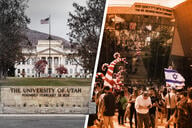You have /5 articles left.
Sign up for a free account or log in.
Campus Uprisings: How Student Activists and Collegiate Leaders Resist Racism and Create Hope (Teachers College Press) is a collection of essays on the motives for campus protest and the results. The authors wrote their essays before the current protest movement, but the editors answered questions about that movement as well.:
The editors -- Ty-Ron M. O. Douglas, an associate professor of educational leadership and policy analysis at the University of Missouri; Kmt G. Shockley, an associate professor of educational leadership and policy studies at Howard University; and Ivory A. Toldson, a professor of counseling psychology at Howard University -- responded to questions via email.
Q: Your book is strongly sympathetic to the students who are rising up in protest. Why?
A: Few leaders and institutions seem willing to address student needs before they become demands. The fact is that most "advances" toward justice were demanded rather than given. And when you understand the history of oppression in this country and on college campuses -- particularly for Black people -- you understand that contemporary campus uprisings are typically grounded in and in response to long-standing issues and documented injustices.
We sympathize with students who must protest to instigate change because they come to our campuses to "get an education"; yet many of them, without the cover of tenure or prestige, give us an education on courage while wading through toxic environments in the process; we sympathize because they are often misunderstood and maligned in the process -- with their youth and supposed immaturity cited as proof that they are wrong in the moment, only for revisionist historical narratives to later concede that they were actually the ones on the right side of history in the first place. Frankly, it really isn’t their responsibilities to demand justice, to ask that our campuses be antiracists or to have to request equitable learning environments; yet, over and over, students are the ones who typically carry the heaviest burden and disproportionately suffer the most significant emotional, spiritual and educational trauma as a result. In this respect, their protests are often an additional tax on exorbitant tuition.
The reality is that oppressors do not concede power or opportunity willingly. Some seek to frame college students who resist as troublemakers when they are actually truth tellers, who expose the stench of campus and societal norms that older generations have accepted as ubiquitous and unchangeable. We must remember that some of the most significant movements for justice began on or were incubated on college campuses, yet some of the most vociferous detractors of uprisings for justice are individuals who on Saturday or Sunday would claim to be Protestant. The hypocrisy is blinding to some, but to many it is obvious and must be challenged. Moreover, campus uprisings are exemplars of place-based resistance that cannot be disassociated from broader societal resistance movements and leadership for justice -- youthful leadership that is critiqued as problematic at the time, but courageous in retrospect; we must never forget that many of the civil rights icons who were celebrated posthumously (e.g., Dr. King) or once they aged (e.g., Rosa Parks, Angela Davis) were hated, criminalized and, in the case of some, killed in their youth. Much like oncologists and other medical personnel do not cause cancer but rather identify and/or diagnose it, students who protest to bring attention to the cancer and pandemic of racism are not the problem and should not be blamed for legitimate discontent.
Q: You discuss protest at historically Black colleges. Many would think that wouldn’t be necessary. How are protests at HBCUs different from at predominately white institutions?
A: One of the major differences between protests at HBCUs and predominantly white institutions is that HBCUs sometimes seek out faculty members who have dedicated their careers to studying Black communities. While there are PWIs that hire Black faculty members with Black research agendas, some HBCUs find great value in such faculty members and hire numerous faculty members on their campuses doing that work in such ways that may not be as valued at PWIs. Therefore, often Black students at PWIs feel as though Black faculty members who are interested in closely mentoring them are missing from their experiences on PWI campuses, and their protests are often related to the need to hire more Black faculty members. Conversely, Black students at HBCUs often find themselves protesting problems related to living conditions on campus, customer service issues with university administration, problems related to the financial aid office and/or campus rules and policies that are outdated (such as stringent visiting hours in single-sex dormitories).
Q: What was the state of the protest movement to resist racism before the killing of George Floyd?
A: Before the killing of George Floyd, many college students and members of the Black community were making their voices heard online. For example, many college students were raising major issues related to tuition and fees they were paying to universities for what they deemed to be an inferior online educational experience. In addition, African Americans across the country protested in the streets when Breonna Taylor and Ahmaud Arbery were killed. Prior to that, there were numerous protests when police killed Alton Sterling, Eric Garner, Philando Castile, Walter Scott, Sandra Bland and Michael Brown, all of which occurred prior to the murder of George Floyd. The contemporary protest movement to resist racism has been active ever since the death of Trayvon Martin in 2012.
Q: Because the killing also took place at a time that most campuses were empty, there were few protests on campuses. Do you expect the protest movement to be more vocal on campus when students return?
A: Absolutely. There is a proverbial "perfect storm" brewing. George Floyd’s death hit different. It hit different because we are in the midst of a global pandemic that has disproportionately maligned Black families’ health and finances and temporarily eliminated the lubricant of live sports -- a numbing agent that often serves as a red herring to systemic analysis and revolution. Without college sports potentially this fall, similar distractions will be eliminated. We must remember that racist monuments have fallen across this country and across the world, yet some of the most resistant strongholds and despotic leadership is on college campuses, where leaders refuse to be on the right side of history. Students will not be silent when they return to campus to find that their leaders who -- claiming to be committed to diversity, equity and inclusion -- do not see the contradiction in forcing students to daily walk past racist monuments and imagery.
We must remember that George Floyd’s murder is a sort of bookend to a season of Black death at the hands of police in the era of social media that began with the tragic murder of Michael Brown in 2014, which precipitated some of the most visible contemporary protests, including the Mizzou uprising of 2015.
We expect the protest to be more vocal because there is a lack of diplomacy from the leader of the White House. When Michael Brown died, we had an eloquent and intelligent Black president in the White House; yet, there was still no justice for Michael Brown. We now have a president of this country who has given voice to the ugliness of white supremacy from the highest governmental position and has no problem spewing racist vitriol on Twitter -- we expect that there will likely be standoffs in that space as the U.S. president engages Twitter and students make their voices heard on campus and on social media in the fall.
Q: What are the key things that Black students and other minority students want from university administrators?
A: Traditionally white institutions that were established before the Civil Rights Act of 1964 operated when it was legal to discriminate against Black people and other minority students. These institutions have accumulated wealth, directly and indirectly, because of slavery, betrayals during Reconstruction, rioting and lynchings that targeted Black business districts, Jim Crow laws, redlining, and discriminatory hiring and lending practices. Blatant symbols of this racist history are still prevalent at most institutions of higher education, in the form of names on buildings, monuments and memorials. However, this history is most evident in the wealth and resource gaps between Black and white students.
Black students want university administrators to examine their histories and to make the necessary modifications to their campus environment and practices to reflect the diversity of today. Institutions have an obligation to remove symbols of racism and to compensate minority students for the pain and suffering in which they were complicit. Black students and other minorities need creative and meaningful strategies that require earnest institutional investments. Key things like removing and replacing racist symbols, funding for diversity hires, diversity scholarships, diversity internships, diversity training programs, housing for Black organizations that are comparable to white fraternity houses, endowed chairs for national experts on social justice, summer bridge programs are a few noble investments that administrators can support.




